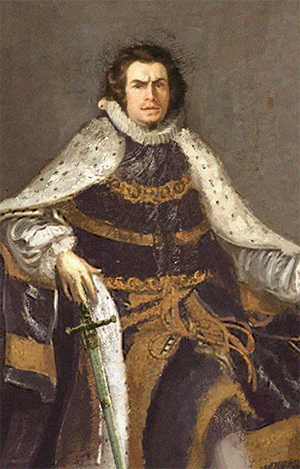Richard III
Richard III (2 October 1452 – 22 August 1485) was King of England and Lord of Ireland from 26 June 1483 until his death in 1485. He was the last king of the House of York and the last of the Plantagenet dynasty. His defeat and death at the Battle of Bosworth Field, the last decisive battle of the Wars of the Roses, marked the end of the Middle Ages in England.
Early life
Born on October 2nd, 1452 in Northamptonshire during England's contentious War of the Roses, Richard was the eleventh of twelve children of the 3rd Duke of York, who was the head of the House of York. His first brush with conflict came at age seven when he was captured as a prisoner of war by soldiers from the rival House of Lancaster. This imprisonment only lasted a few days thanks to the arrival of his eldest brother Edmund, who scattered the enemy troops and arranged for Richard and the rest of his young siblings to be safely lodged in London.
Beginning at age fourteen, Richard, having been raised to the royal rank of Duke of Gloucester by his brother, King Edward IV, began his military training. He came to enjoy hunting and swordplay and was extremely good at both. Richard's physical proportions were short and slight, with one shoulder being higher than the other, a condition caused by scoliosis that grew more pronounced as he aged.
Military career
On May 4th, 1471, the competing armies of the House of York, led by King Edward, and the House of Lancaster, led by Prince Edward, son of Henry VI, met on the field of battle at Tewkesbury. Richard was appointed captain of a third of the army and given command over the right flank. While the forces in the center of the field engaged in combat, Richard ordered a hail of arrows and artillery fire aimed at the Duke of Somerset, the most capable Lancasterian commander.
As Somerset's army fell into disarray, Richard charged the center of the enemy line. Within a few short hours, Prince Edward was dead and the House of York claimed victory over their longtime adversaries. Richard was only eighteen years old and Prince Edward was only seventeen.
Rise to power
After peace was secured, Richard courted and married Lady Anne Neville, who had not only been the dead Prince Edward's wife, but was also Richard's cousin. They had been close friends as children, and he assured her that, despite her first husband's death, she would rule beside him as the Queen of England someday. Lady Anne stood to inherit a vast fortune and titles, which is part of the reason his brother George, Duke of Clarence, attempted to oppose the marriage. Only by agreeing to give up certain titles and royal offices could Richard secure permission for the marriage to Lady Anne to go forward.
This may have motivated Richard to have the Duke of Clarence put to death. His wife, Isabel, died under mysterious circumstances, but the duke was confident she had been poisoned by one of her ladies-in-waiting. Shortly after, the duke's personal astronomer, John Stacey, was arrested and tortured until he confessed to having cast a horoscope that foretold the death of King Edward.
The Duke of Clarence was then confined to the Tower of London on charges of treason for directing John Stacey to use black magic to cause the death of the king in an unnatural fashion. In arranging this ruse, Richard simply copied the same sequence of events involving astrologer Roger Bolingbroke and King Henry VI nearly 40 years earlier. On February 18th, 1478, the Duke of Clarence was executed by being drown in a cask of wine while imprisoned in the Tower.
Warden of the Marches
From this point forward, Richard was given supreme command over the armies of the north as Lieutenant-General of the North and Warden of the Marches. In this capacity, he successfully subdued any signs of rebellion from English nobles and won numerous small incursions on the border with Scotland. He also engaged in diplomacy with the Scottish king and his followers, ensuring peaceful settlements to disputes when possible. Having proved himself capable as a fighter and a statesman, Richard became a national hero in Parliament, where he was viewed with the highest esteem.
King of England
As King of England, Richard did not reign long enough to have a significant impact on national affairs, aside from founding the College of Arms. His two-year rule was cut short by the rebellion of his old allies and the return of Henry Tudor from exile with an army that hoped to overthrow him. Their forces met at the Battle of Bosworth in central England. Although Henry was outnumbered, Richard's troops were outmaneuvered and his commanders didn't have the stomach for battle.
Even though Richard himself fought with his old ferocity, he was struck down during the heavy fighting by a Welsh soldier. The blow that killed him was said to be so forceful that it drove his helmet through his skull, crushing it completely. With Richard's death at the age of thirty, the houses of York and Lancaster were all but extinguished and the War of the Roses was over.
Disposition of body
After the Battle of Bosworth, Richard's body was buried in Grey Friars Priory in a crude grave which was subsequently lost when the priory was demolished in the 1500s. In 2012, his bones were discovered during an excavation at the site of the old priory. The skeleton showed signs of scoliosis and wounds consistent with death in battle, including a crushed skull. The following year, a DNA test was conducted which proved beyond any doubt that the remains were those of Richard III. His bones were given a proper burial in a specially made tomb in Leicester Cathedral near the site of his original burial place.
